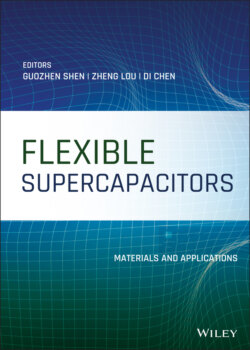Читать книгу Flexible Supercapacitors - Группа авторов - Страница 40
2.3.1 Compressible SCs
ОглавлениеCompressible SCs have emerged as a new branch of stretchable SCs. Compared to stretchable electronics, compressible SCs endow the large levels of strain without sacrificing basic electrochemical performance. Traditional compressible SCs usually use graphene, SWCNTs or their composite foam as electrode materials, which can't be compressed into one unit due to the liquid electrolyte and incompressible encapsulation. To address these problems, Niu et.al proposed a nanostructured composite sponge based all‐solid‐state SCs with a remarkable compression tolerance [75]. The PANI@SWCNTs sponge electrode materials were synthesized as follows (Figure 2.13a): the sponge was cut into required shapes and then repeatedly dipped with SWCNTs solution. After drying, the electrochemical deposition process was performed to coat a PANI nanomaterials on the surface of the SWCNTs covered sponge. The mass loading of SWCNT and PANI was 2.2 and 4.1 mg cm−2, respectively.
Figure 2.13b showed the schematic diagram of the cross‐sectional scheme of the fabricated sandwiched compressible SCs. Two patterned Au film on poly(ethyleneterephthalate) (PET) served as the current collector attaching to the outer‐top and outer‐bottom side of sponge electrodes, separated by filter paper and PVA/H2SO4 gel electrolyte. The single device during stress‐release cycle was illustrated in Figure 2.13c. Figure 2.13d displayed the CV curves under different compressible strain. The specific capacitance of PANI@SWCNT sponge electrodes based all‐solid‐state SC calculated from CV curves was 216 F g−1. Almost 97% of capacitance retention was maintained even under 60% compressible strain. Furthermore, four SCs (Figure 2.13e and f) were connected in series to improve the overall output potential, which was powerful enough to light up an LED. We can see the brightness of the LED under compressible strain (Figure 2.13g and h) did not show any noticeable change with a compressing releasing cycle, demonstrating the excellent stability of the compressible all‐solid‐state SCs, which will pave the way for practical applications of SCs in the field of compressible energy storage devices to fit the demands of the compression‐tolerant electronics.
Figure 2.13 (a) Schematic diagram of synthesizing PANI@SWCNTs sponge composite electrodes. (b) Cross‐sectional scheme of the fabricated PANI@SWCNTs sponge based SCs. (c) Real‐time optical images of the SCs under compressing. (d) CV curves of the compressible SCs with increasing strains from 0% to 60%. (e) Photography of the patterned d Au current collector on PET plate. (f–h) Lighting test driven by four SCs showing the compressing and recovering process.
Source: Reproduced with permission [75]. © 2015, Wiley‐VCH.
